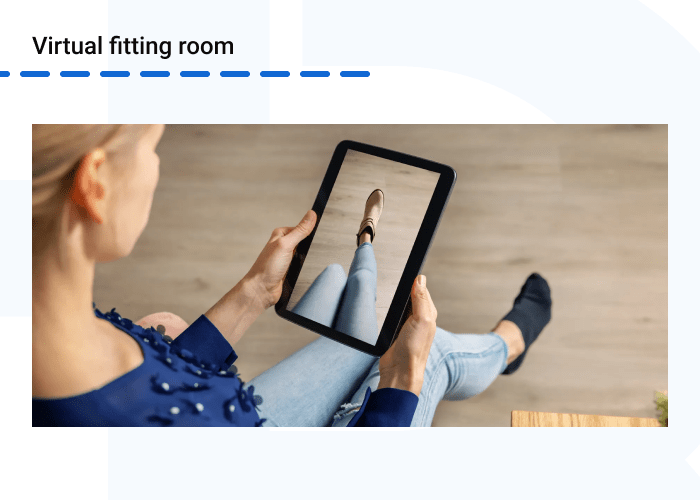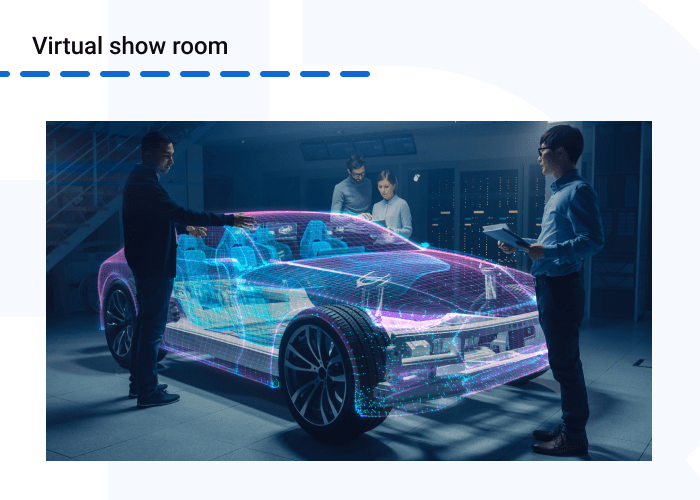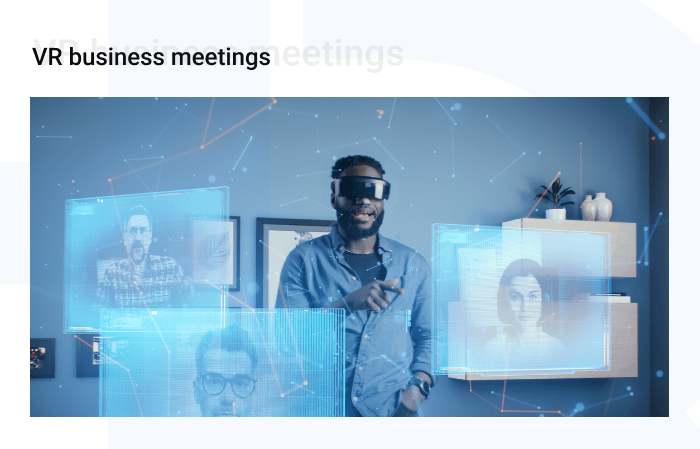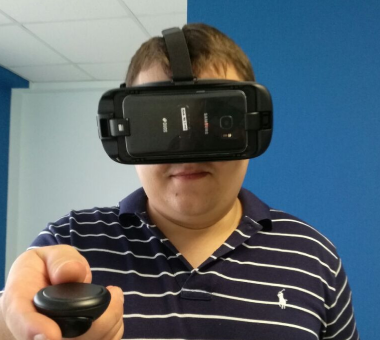AR/VR in Media and Entertainment
AR/VR for Training and Education
AR/VR in the Automotive Industry
Augmented and Virtual Reality (AR/VR) has moved far beyond the world of gaming. Now it’s a powerful technology that can provide a unique customer experience, increase user engagement, improve employee efficiency, and boost business productivity.
That’s confirmed by our clients who have already significantly improved their performance by implementing AR/VR. So we’ve created this comprehensive guide to help you find the perfect way to implement these technologies in your startup.
Whether you’re already familiar with Augmented and Virtual Reality and their implementation in various fields or have no idea whether such a solution is right for your business, this guide will bring you many insights and useful resources for learning how to leverage AR/VR for your industry.
AR/VR in Media and Entertainment
AR/VR for Training and Education
AR/VR in the Automotive Industry
Before exploring use cases of AR/VR technologies, it’s important to make sure we’re on the same page and that you understand what the difference between AR and VR is. We’ve summarized the key differences in the table below.
| Augmented Reality | Virtual Reality |
| Overlays virtual objects and 2D elements over a real-world image, enhancing instead of replacing it. | Fully replaces the image of the real world you see with a virtual one and immerses you in a new virtual environment. |
| Available and affordable to the majority of businesses and consumers. | Relatively expensive to develop, available only to users who can afford VR hardware. |
| Can be consumed on the go: on the street, at stores, etc. | More likely to be experienced at home or in a specifically equipped space. |
Augmented and Virtual Reality technologies also differ in the devices needed to start the virtual experience.
In the case of AR, you don’t necessarily need complicated hardware. Common mobile devices such as smartphones or tablets can be enough. However, a more immersive experience may require other equipment:
Virtual Reality, in turn, is a more complex technology and requires advanced hardware, such as:
Now that we’ve outlined the difference between the technologies in a nutshell, we can move on to look at AR/VR implementation in various industries. Each section below will focus on the use of Augmented and Virtual Reality in a particular industry and offer insights into how to gain even more benefits.
Advanced technologies in retail are primarily aimed at improving the customer journey and increasing consumer satisfaction. Augmented and Virtual Reality can enhance pre-sales, purchasing, and post-sales support activities by offering engaging and interactive techniques such as “try before you buy,” virtual makeovers, visual manuals, etc.
As online shopping continues to grow in popularity and the number of online shoppers is increasing, AR/VR has much to offer in this area. This is where virtual stores come into play.
Virtual stores allow customers to feel like they are inside a brick-and-mortar store and can virtually interact with products. This pushes visitors to make a purchase and helps reduce returns. Such shops are suitable for almost any kind of product, from clothes to furniture, and even allow for virtual grocery shopping.
To make the customer experience more immersive and help consumers make decisions faster, virtual stores implement virtual fitting rooms, allowing users to try on clothes and accessories using virtual avatars on mobile devices or with smart mirrors. The solution is useful for both online and offline shopping.

More often, we can experience virtual fitting rooms on mobile devices. The solution can be relatively simple, but it nevertheless enables brands and retailers to increase sales as well as user engagement.
Do it: learn more about how AR improves retail
Entertainment is the field considered a most natural fit for Augmented and Virtual Reality, as it includes interactive gaming. However, games aren’t the only possibility. We can offer many other use cases here.
For example, you can apply AR/VR in social media to create interactive masks and filters, which can boost user engagement and increase brand awareness. How to achieve this? One example is running a challenge on social media with themed hashtags, which can also become a part of an advertising campaign.
Virtual and Augmented Reality in advertising help companies stand out from their competitors, provide something more eye-catching than traditional 2D ads, and reach potential users more effectively. Such ads also contribute to increasing brand visibility, as interactive and well-designed content creates vivid and lasting impressions, encouraging people to spread the word about it.
Need to create an AR/VR solution? We’re here to help!HQSoftware has a team of skilled professionals ready to tackle the project. Let’s talk!
Anna Halias
Business Development Manager
You can also enhance a live show, such as a music or art festival, with an AR experience. For example, to promote an art festival of ethnic music, our client turned to our company to build a mobile app that provides visitors with visual information about festival objects, including audio, video, image, or web content. With this app, the client was able to attract more visitors to the event and increase their engagement and satisfaction.
One more idea is to use AR/VR for virtual tours. For example, a virtual tour of rental and sales properties significantly enhances the offerings of real estate companies and provides users with more convenient access to the real estate market.
A last but not least example is the use of Augmented and Virtual Reality for museums. These technologies help museums expand their target audience, enrich the user experience, create additional revenue streams, and make efficient use of exhibit space. With AR/VR, you can successfully combine old traditions and modern trends to offer content that satisfies all segments of your audience.
Do it: explore 5 reasons to implement AR in media and entertainment
AR and VR in education open up numerous opportunities that allow you to:
Using AR in education provides cheaper solutions compared to VR, but with more limited functionality and visualization. For a more immersive learning experience, you should choose Virtual Reality.
Virtual Reality in education isn’t used exclusively by educational companies; it also enables companies in any industry to provide Virtual Reality training for staff.

For example, you can reduce product waste by pre-training employees in a virtual environment or decrease onboarding time. Such training is useful for any type of education, from soft skills development to flight training.
With custom AR/VR development, you can even create your own professional learning program that can be used for training workers from the beginning and later to expand the skill sets of current employees and train newcomers specifically to your needs.
One important aspect of staff training you can enhance with Virtual and Augmented Reality is safety training. Using these technologies allows workers to practice in a safe virtual environment, avoiding injury or damage to equipment or finished products.
Do it: find out how to avoid common pitfalls when developing a VR training project
By using Augmented and Virtual Reality in manufacturing, you can think more innovatively and significantly upgrade your manufacturing processes. The technologies provide visualization and automation, allowing you to overcome manufacturing challenges and find a good balance, delivering high-quality products while minimizing costs and material waste. This can be achieved because AR and VR can help:
The list can go on, as high-quality AR/VR solutions bring value to almost every part of the manufacturing process, making them cost-effective and less time-consuming and help you stay competitive in a tough commercial environment.
Do it: learn how VR benefits the oil and gas industry
This section closely overlaps with the section above, as the automotive industry gets roughly the same benefits from AR and VR as manufacturing. But we would still like to describe several use cases separately.
First, using VR in automotive design helps in performing virtual testing and training of self-driving cars. To ensure safety and eliminate road accidents, self-driving cars must be able to deal with a huge variety of scenarios such as parking, lane changing, and recognizing hazards. Virtual Reality allows for achieving this in a virtual environment, reducing training time and costs.
Secondly, AR and VR are used by automotive companies to enhance product showcasing. This includes digital showrooms, advanced car advertising, and even virtual rides. The latter provides customers with the opportunity to try the car’s features in the virtual environment before making a purchase, which improves decision-making. For companies, in turn, it’s an opportunity to offer a test drive to everyone without actually using the car.

Finally, Augmented Reality technology for automotive purposes improves after-sales service. The technology allows you to create advanced user manuals and provide contextual and visual guidance to facilitate complex maintenance procedures such as oil changing. This increases customer satisfaction, boosts trust and loyalty, and helps you stand out from competitors.
Do it: learn how a VR distorted simulator enhances driver training
Implementing AR/VR solutions in healthcare can be quite complicated, as such software requires compliance with numerous standards and must pass multiple testing levels to get approval.
However, high-quality AR/VR app development can bring much value to your operations. Especially since healthcare providers and patients agree that VR is essential for the healthcare industry to improve education and routine care.
Key uses of Augmented and Virtual Reality in healthcare include:
In every case, cutting-edge technology leads to improved medical work and more effective treatment, helping the medical community save even more lives.
Do it: explore how to apply VR simulations in healthcare
In the remote work environment, AR/VR has offered new insights to improve workplace collaboration. Employees in different locations can move into a virtual space that resembles a meeting room in an office and hold VR conferences or business meetings there. It also enables employees to work on the same project remotely, not only discussing the work but actually doing it, for example during prototyping or designing.

Even if you’ve already adopted a hybrid working model or are gradually returning to the office, don’t skip this section! Managing a distributed team can be even more challenging than a fully remote team. So, AR/VR has much to offer for this field as well.
For example, AR app development for video conferencing allows the creation of 3D avatars that can join other meeting members and mask the physical absence of remote teammates. Such an experience requires AR glasses.
In addition to solutions for meetings, Augmented and Virtual Reality development can also enhance corporate events. Here you can leverage AR development to add visualization during presentations and conferences, use VR for team building, enhance product showcasing with 3D models, or implement AR and VR for training employees. In fact, you can come up with many other ideas that will be relevant to your employees and increase their satisfaction and efficiency.
Do it: watch a video on how to enrich workplace education with VR
As AR/VR development and implementation can be both challenging and costly, your executives may be skeptical about such a solution or doubt that it’s worth the investment. To explain the business value that top-notch technologies can provide, you should be able to pitch an AR/VR project to your client or top managers.
Here are some tips to help you improve the presentation:
With thorough research, you can overcome concerns about implementing AR/VR solutions and take advantage of their potential to increase your business’s efficiency and establish a reputation as an innovative company.
Do it: learn how an outsourcing dev team helps reduce AR/VR app development costs
After exploring several use cases for AR/VR technologies in various industries and their benefits, are you still doubtful? Here are some statistics and forecasts about the future of AR/VR.
The AR/VR market is expected to grow to $77.76 billion in 2025 and reach 2.593 million users by 2027. In terms of the business environment, about 91% of tech enterprises are already using or planning to implement AR/VR technologies. It’s expected that, by 2030, 23 million jobs will use AR/VR for training, meetings, and product development.
The future of Virtual Reality is also driven by several important trends, such as the combination of VR with Artificial Intelligence, the rapid development of Metaverse, and hardware improvements.
AR/VR devices are becoming less bulky and more accessible to consumers, which greatly contributes to widespread AR/VR adoption. In addition, upgraded devices such as smartphones with improved cameras and LIDAR scanners as well as 5G networks will make the immersive experience easier to enjoy.
Andrey Kazakevich
Head of Production
at HQSoftwareWhile we’ve already had numerous examples of AR/VR use, the possibilities of the technologies are still being explored. The market for AR/VR solutions is actively evolving, so I believe the demand for AR/VR projects will only grow. And combining AR/VR with other advanced technologies such as IoT or AI provides us with even more feature-rich solutions.
In fact, you can probably come up with lots of other ideas for using AR/VR beyond those we’ve mentioned in this guide. The capabilities of these technologies are broad enough to cover almost all business needs.
However, very often the off-the-shelf market limits your options, so it can be hard to choose a suitable solution. In this case, you can turn to custom AR/VR app development.
As an AR/VR app development company, we provide a variety of services, from AR/VR consulting to full-cycle development, to satisfy every business need. We carefully study project requirements and provide options that meet your demands in the best possible way.
With 10+ years of experience in offering AR/VR design and development, we know how to handle the main AR/VR challenges to ensure quality and realistic content, seamless app performance, and a high level of security. For example, with an AR app that provides high-quality visual assets, our client was able to visualize potential constructions on the building site to attract more investments in building projects and increase sales.
Our software specialists also work with other technologies, so we can enhance your solution with advanced data visualization, real-time data processing, smart device connectivity, and more. For example, to create a mobile app that allows for simplifying scanning and measuring the location of underground cables, our developers had to ensure a seamless connection with navigation systems and enable real-time data processing. The app now helps improve the workflow of telecommunication and energy network companies and monitor contractors in real time.
At HQSoftware we are focused on providing high-quality and cost-effective solutions that can bring outstanding results to your startup. That’s why AR/VR development with HQSoftware is all about hands-on expertise gained over the years, strict adherence to the plan and deadlines, and transparent communication throughout the entire collaboration.
Visit the AR/VR development page to learn more about how we can enrich your business with AR/VR solutions.

AR/VR Expert
A developer with extensive expertise in AR/VR, very ingrained into the topic of Mixed Reality development. Shares his knowledge and the results of many years of work.
We are open to seeing your business needs and determining the best solution. Complete this form, and receive a free personalized proposal from your dedicated manager.

Sergei Vardomatski
Founder